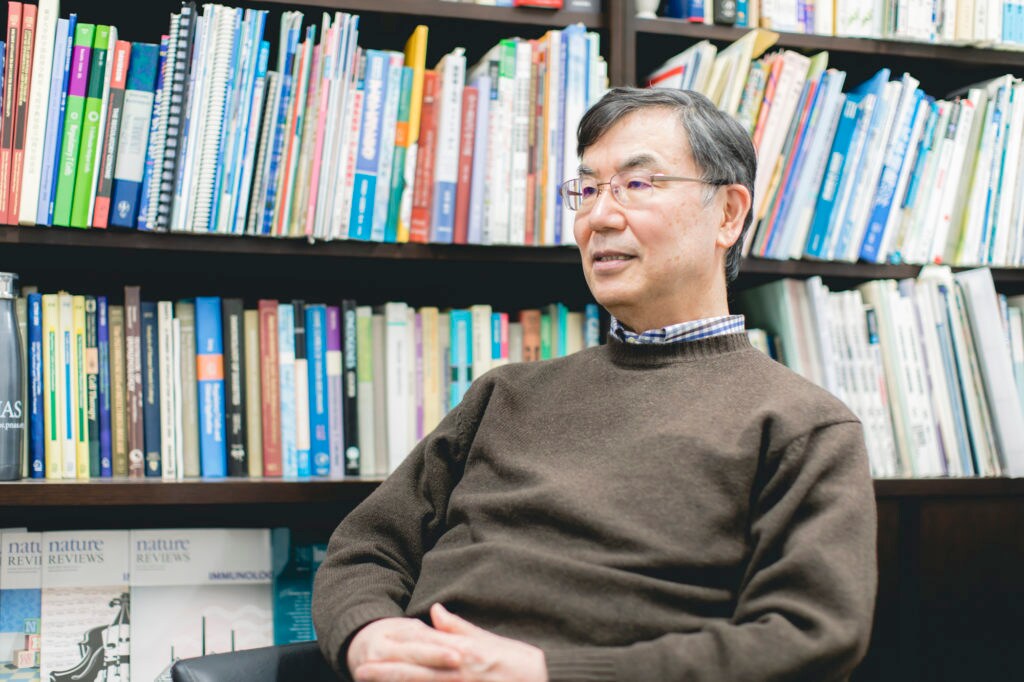A landmark discovery of Treg cells, or regulatory T cells, carries the potential to fight diseases affecting broad populations – from allergies to autoimmune disorders to cancer.
The human body is equipped with a powerful ability to fight off infections and toxins it views as threatening. Our immune systems recognize the difference between normal cells and foreign cells, and today they present a unique area of opportunity, as researchers have made tremendous progress in understanding how immune systems work and are harnessing that knowledge to fight cancer and other diseases.
For Shimon Sakaguchi, MD, PhD, professor of immunology at the Frontier Research Center at Osaka University, the immune system has long seemed an area of untapped potential. In 1995, his lab made the landmark discovery of Treg cells, or “regulatory T cells,” which suppress the immune system when it is in overdrive. Today, he continues to use genomic analysis to study the role of these cells and their potential to impact clinical care.
“I would like to use the results of our basic research to treat and prevent diseases that affect so many people; for example, allergies, autoimmune diseases and cancer,” Dr. Sakaguchi said. “The immune system is flexible and finely balanced, and we believe that it’s possible to control immune responses by slightly adjusting this balance.”

Dr. Shimon Sakaguchi, MD, PhD
The Path to Discovery
Shortly before describing Treg cells for the first time, Dr. Sakaguchi had just begun his postgraduate career when he came across a paradoxical finding from research performed at the Aichi Cancer Center in Nagoya. The researchers hypothesized that removing the thymus, an organ responsible for producing T cells, in mice would result in a reduced immune response. Instead, removing the thymus elicited a stronger immune response in the mice – one that resembled human autoimmune disease. Fascinated by this discovery, Dr. Sakaguchi dropped out of his postdoctoral program to join the researchers in Nagoya to study this further.
Their studies led them to a theory that, perhaps, self-reactive lymphocytes are constantly in the body but are often suppressed from responding. Lymphocytes are a type of white blood cell that can initiate immune responses when foreign, threatening cells enter the body. Dr. Sakaguchi was one of the lone scientists who strongly supported this hypothesis due to previous research he conducted, and he set out to test the theory.
Discovering Treg Cells
Following years of collaboration with other scientists around the world, Dr. Sakaguchi and his team used genomic analyses to discover what is now referred to as “Treg” cells and regulatory “T” cells.
“We tried many markers to select cell populations while also demonstrating the presence of cells that suppress immunity in normal mice,” Dr. Sakaguchi said. Finally, his team found CD25 cells in the mice. CD25 cells promote T cell proliferation, making them a potential biomarker for increased immune activity.
However, Dr. Sakaguchi’s research did not stop there. During his career, his lab hypothesized that IPEX syndrome, a disease that can cause intense autoimmune disorders, was linked to a gene known as Foxp3. As their work advanced, Dr. Sakaguchi and his team were tasked with attempting to find the link between Foxp3 and Treg cells. The goal was to figure out how one singular genetic abnormality could cause severe autoimmune disorders and symptoms. Their findings were extraordinary.
“We were able to functionally convert normal T cells into Treg cells by expressing Foxp3 on normal T cells. We reported that this gene is the master gene of Treg cells, and that Treg function is impaired due to abnormalities in the Foxp3 gene, causing various immune abnormalities,” Dr. Sakaguchi said. “Treg cells are the link between the gene and human diseases.”
The Potential to Fight Cancer with Treg cells
Having greatly advanced knowledge on the role of Treg cells in the human body, Dr. Sakaguchi is now focused on enabling treatments that leverage Treg cells to elicit an immune response. His goal is to harness the power of the immune cells that exist naturally in our bodies to fight disease, including cancer, rather than relying on surgery or drugs.
“By using the antigen specificity of Treg cells,” he said, “we are considering a treatment method that precisely suppresses the immune response against self cells and tissues or transplanted non-self cells. It will not affect the immune response that attacks viruses and pathogens.”
This treatment approach could have applications including treating autoimmune disease, allergies, inflammatory bowel disease (IBD), and cancer, as well as complications after organ transplantation.
There is still work to be done when it comes to using this method in cancer treatment. Immune-checkpoint inhibitors have shown some success activating an immune response, but the response remains limited.
“Because Treg cells are also involved in the immune suppression of anti-cancer immune responses, it is possible that a higher therapeutic effect could be achieved by precisely releasing only the inhibitory mechanism on cancer tissues,” Dr. Sakaguchi said. “We are working on the next generation of cancer treatment and the development of new cancer preventive measures.
Read the full interview on Dr. Sakaguchi’s research or learn about the other ways Applied Biosystems are helping researchers answer their cancer genomics questions.
Leave a Reply